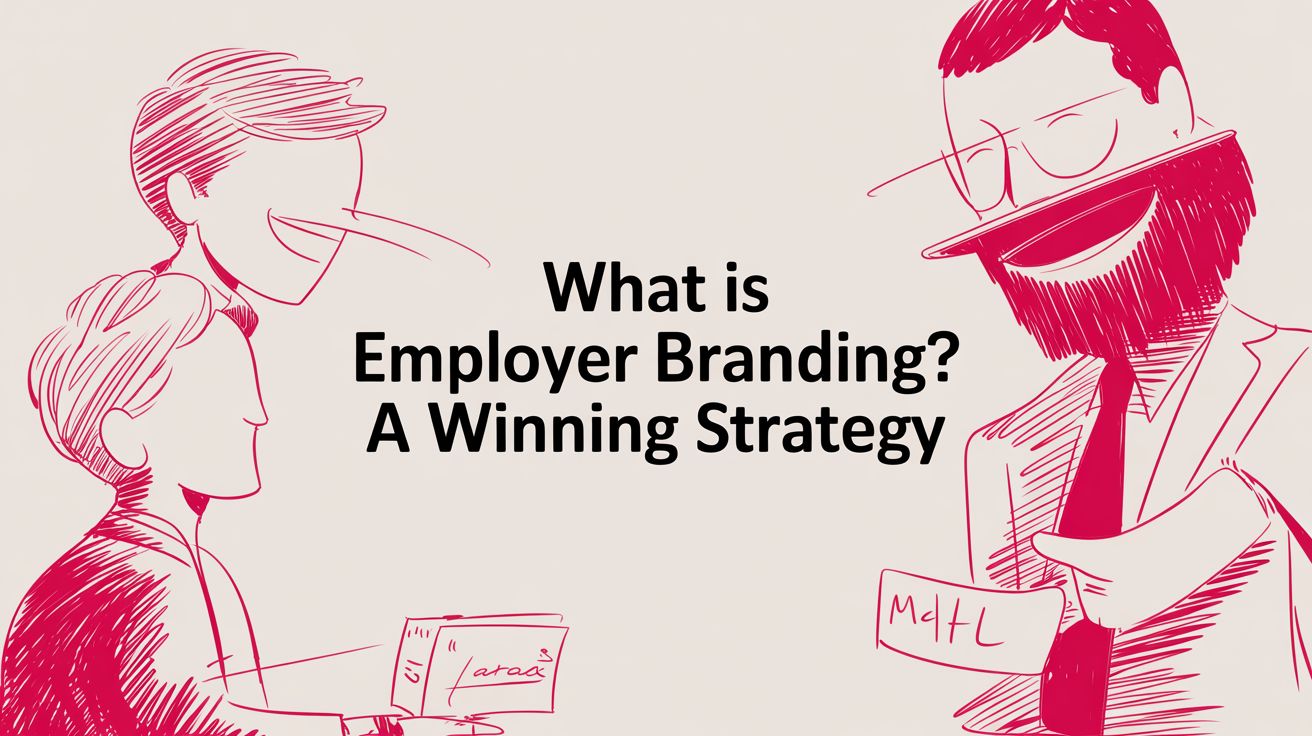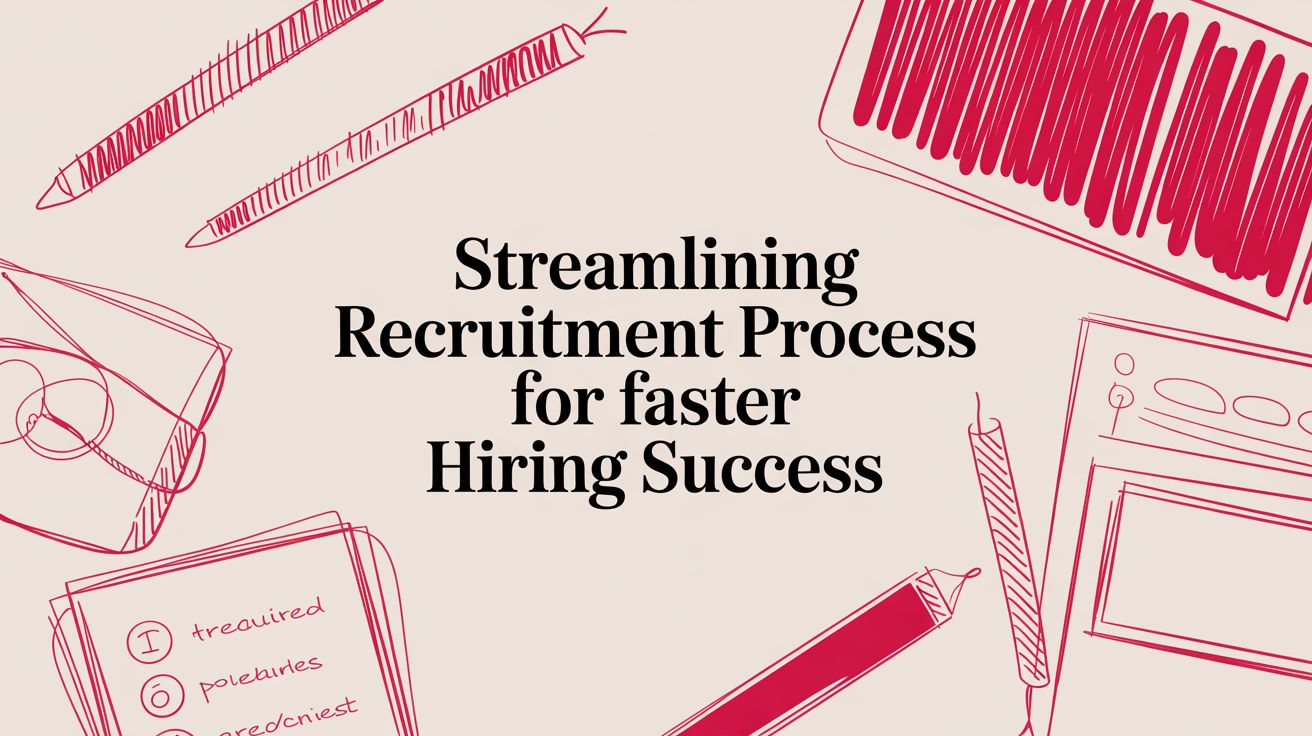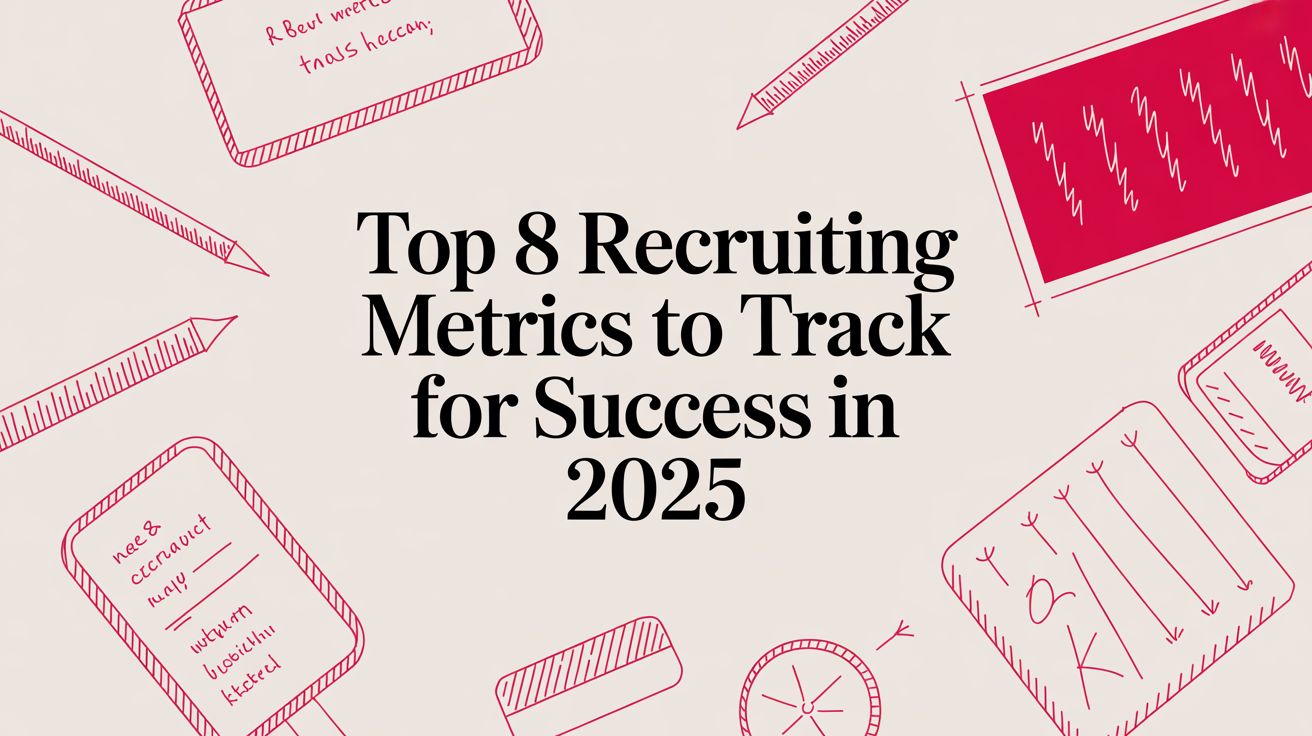Creating a Candidate-Centric Hiring Journey
Want to improve candidate experience and attract top talent? This listicle provides seven actionable strategies to revamp your hiring process. Learn how to create a positive and respectful experience that strengthens your employer brand and secures the best candidates. From streamlined applications and transparent communication to personalized interactions and feedback mechanisms, discover how to build a truly candidate-centric hiring journey. These tips will help you stand out in a competitive job market and build a strong talent pipeline for 2024 and beyond.
1. Streamlined Application Process
One of the most impactful ways to improve candidate experience is by streamlining the application process. This involves minimizing friction points and reducing the time candidates spend applying for positions. A lengthy, cumbersome application process can deter qualified candidates, particularly those who are passively searching and aren’t willing to invest significant time in each application. By simplifying and optimizing the process, you demonstrate respect for candidates’ time and create a positive first impression of your organization. This translates to higher application completion rates, a broader pool of applicants, and ultimately, a better chance of finding the perfect fit for your open roles.
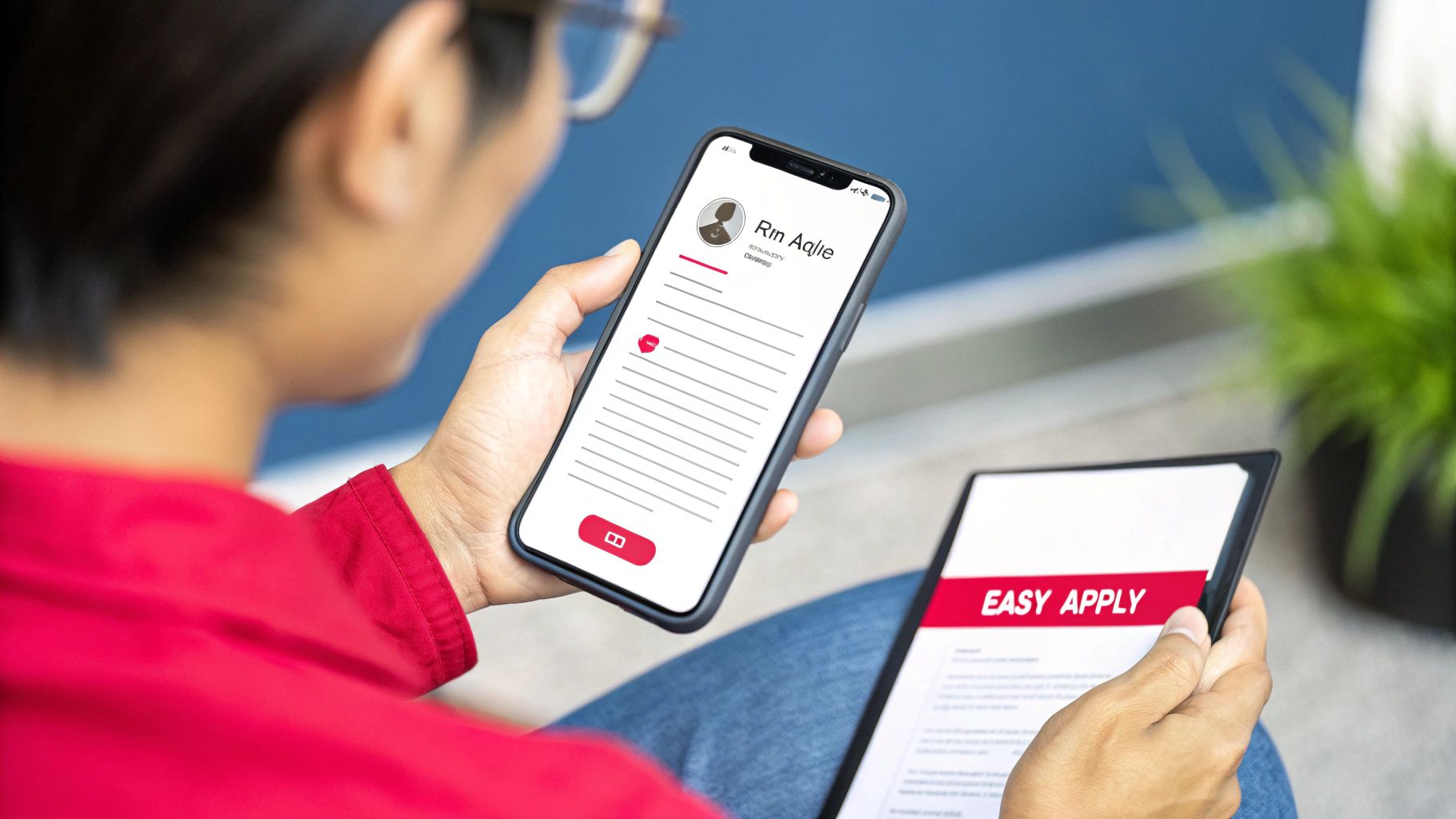
A streamlined application process leverages technology to simplify data entry. Features like resume parsing automatically populate application fields with information extracted from the candidate’s resume, and social media profile imports allow candidates to pre-fill sections with data from their LinkedIn or other online profiles. Mobile-responsive application forms ensure candidates can apply easily from any device, while one-click apply options, like those offered by LinkedIn Easy Apply and Indeed Apply, drastically reduce the time investment required. Progress saving functionality and estimated completion time indicators further enhance the candidate experience by providing transparency and control.
Examples of Successful Implementation:
- Shopify: Reduced their application process to just 15 minutes with simple forms and clear instructions.
- McDonald’s: Implemented a mobile-first application process that can be completed in under 5 minutes.
- IBM: Implemented a streamlined process that reduced application time by 50%.
Pros:
- Reduces application abandonment rates by up to 365%.
- Increases application completion rates.
- Attracts passive candidates who won’t tolerate lengthy processes.
- Demonstrates respect for candidates’ time.
- Creates a positive first impression of the organization.
Cons:
- May collect less initial information about candidates.
- Requires investment in technology solutions (e.g., Lever ATS, Greenhouse Recruiting).
- May increase the number of unqualified applicants.
- Requires regular testing and optimization.
Tips for Streamlining Your Application Process:
- Audit your current process: Have team members apply for jobs to identify pain points.
- Limit required fields: Only ask for essential information upfront. Gather additional details later in the hiring process.
- Implement clear progress indicators: Show candidates how far they are in the application.
- Mobile-first optimization: Design your application with mobile devices in mind.
- Remove redundant questions: Avoid asking for information already provided in the resume.
This approach is particularly beneficial for organizations seeking in-demand talent, especially in competitive fields like tech and digital roles. A streamlined application process helps companies stand out from the competition and secure top talent by making the application experience as smooth and efficient as possible. By prioritizing candidate experience, organizations can improve their hiring outcomes and build a stronger employer brand.
2. Transparent Communication Throughout the Hiring Process
One of the most impactful ways to improve candidate experience is through transparent communication throughout the hiring process. This involves keeping candidates consistently informed about their application status, what the next steps are, and providing feedback whenever possible. This approach builds trust and reduces anxiety, fostering a positive relationship with your organization even if the candidate isn’t ultimately hired. This is crucial for improving candidate experience, as it demonstrates respect for their time and effort.
Transparent communication works by establishing clear expectations from the outset. Instead of leaving candidates in the dark, proactively share information about the hiring timeline, the different stages of the process (e.g., initial screening, interviews, assessments), and what they can expect at each step. This clarity minimizes uncertainty and allows candidates to prepare effectively.
Features of Transparent Communication:
- Automated status updates: Automated emails can keep candidates informed of their progress without requiring manual intervention from recruiters for every single update.
- Clear timeline expectations: Providing a general timeline upfront helps candidates understand how long the process might take.
- Personalized feedback mechanisms: Personalized feedback, even for rejections, shows candidates that their application was seriously considered.
- Regular check-ins from recruiters: Periodic check-ins from a recruiter demonstrate a personal touch and provide an opportunity for candidates to ask questions.
- Clear explanation of all hiring stages: Explaining the purpose of each stage in the hiring process helps candidates understand the overall structure and their place within it.
Pros:
- Reduces candidate anxiety and frustration: Knowing where they stand alleviates stress and uncertainty.
- Builds trust and strengthens employer brand: Transparency fosters a positive perception of your company.
- Decreases the likelihood of candidates dropping out: Candidates are more likely to stay engaged if they know what to expect.
- Improves overall candidate satisfaction scores: A positive experience leads to higher satisfaction, regardless of the outcome.
- Creates advocates even among rejected candidates: Respectful and transparent communication can turn rejected candidates into brand ambassadors.
Cons:
- Requires dedicated resources to maintain communication: Implementing and maintaining transparent communication requires time and effort.
- May create additional expectations for personalized feedback: Candidates may expect detailed feedback, which can be challenging to provide at scale.
- Needs coordination across hiring teams: Ensuring consistent communication requires alignment across all involved parties.
- Potential legal concerns with providing detailed rejection feedback: Care must be taken to avoid discriminatory language or revealing confidential information in feedback.
Examples of Successful Implementation:
- Zappos: Sends personalized emails at each stage of the hiring process with next steps clearly outlined.
- Google: Provides candidates with detailed interview guides and clear explanations of their hiring process.
- HubSpot: Created a dedicated candidate resource hub with FAQs and process information.
Actionable Tips:
- Create email templates for different stages of the hiring process.
- Set up automated but personalized status updates.
- Train hiring managers on providing constructive feedback.
- Be honest about timelines, even when there are delays.
- Consider implementing a candidate portal where applicants can check their status.
When and Why to Use This Approach:
Transparent communication should be employed throughout the entire hiring process, from the initial application to the final decision. It is particularly crucial in today’s competitive talent market, where candidates have multiple options and expect a positive experience. Learn more about Transparent Communication Throughout the Hiring Process This approach benefits all organizations, regardless of size or industry, and is especially important for companies building a remote team, as highlighted in the linked resource. By prioritizing open communication, companies can attract top talent, reduce time-to-hire, and enhance their employer brand.
This item deserves its place on this list because it addresses a fundamental aspect of candidate experience – the need for clear and consistent communication. In a world where job seekers are often left in the dark, prioritizing transparency sets your organization apart and demonstrates a genuine respect for candidates’ time and effort. This approach is not just about filling open positions; it’s about building relationships and fostering a positive impression of your company, which contributes significantly to improving candidate experience. This is especially relevant for remote job seekers, recruiters, and companies in the tech and digital space who are competing for a global talent pool where transparency is highly valued.
3. Personalized Candidate Interactions
In today’s competitive job market, improving the candidate experience is paramount to attracting and retaining top talent. Personalized candidate interactions play a crucial role in achieving this goal. This strategy involves tailoring communications and experiences to individual candidates based on their background, interests, and career goals. This moves away from generic, mass communications toward customized interactions that make candidates feel valued and understood, ultimately improving the candidate experience.
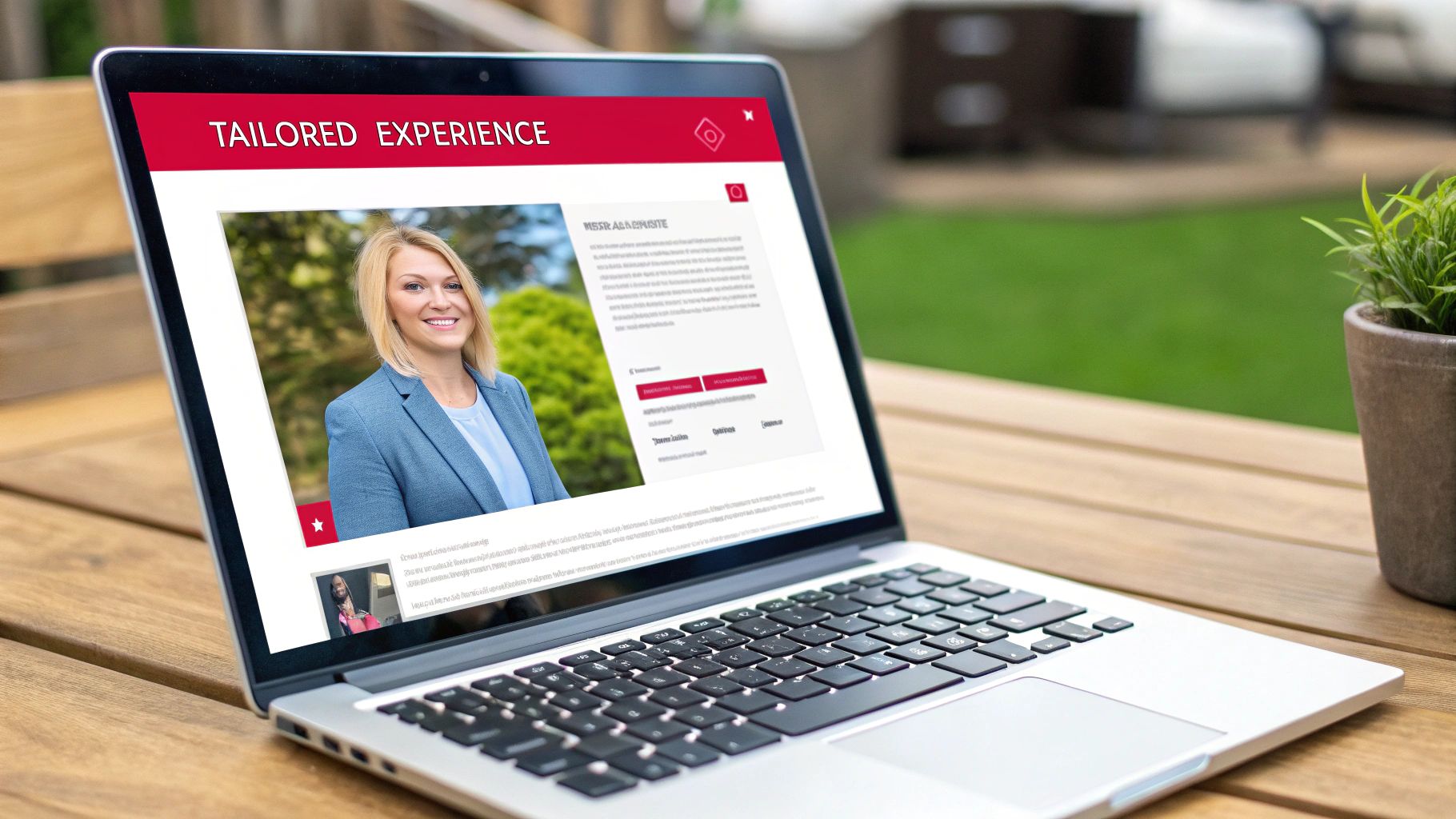
This approach encompasses several key features: personalized email communications, customized interview questions, tailored employer value propositions, role-specific content sharing, and individual career path discussions. For example, crafting personalized emails is a crucial first step. To elevate your email game, explore effective personalized email strategies. Personalized interactions can significantly enhance the candidate experience. Utilizing tools and techniques like those outlined in The Ultimate Guide to Personalized Email Success: Proven Strategies That Drive Results from OKZest can significantly improve engagement and build stronger relationships with potential hires. Further tailoring the interview process by asking questions relevant to a candidate’s specific experience and aspirations demonstrates genuine interest. Finally, discussing potential career paths within the company, aligned with the candidate’s ambitions, showcases a commitment to their long-term growth.
Companies like L’Oréal, Salesforce, and Airbnb have successfully implemented personalized candidate interactions. L’Oréal leverages AI to personalize communications based on career interests and background. Salesforce assigns dedicated recruiters who build relationships with candidates, fostering a more personal connection. Airbnb connects candidates with potential team members who share similar interests, offering a glimpse into the company culture and team dynamics.
Why This Approach Improves Candidate Experience:
Personalized interactions create an emotional connection with candidates, demonstrating genuine interest in them as individuals. This heightened engagement throughout the process leads to increased offer acceptance rates and differentiates your company from competitors.
Pros:
- Creates emotional connection with candidates
- Demonstrates genuine interest in the individual
- Improves candidate engagement throughout the process
- Increases offer acceptance rates
- Differentiates your company from competitors
Cons:
- Time-intensive to implement at scale
- Requires sophisticated candidate data collection
- May create inconsistencies in the hiring process
- Needs balance to avoid appearing intrusive
Tips for Implementation:
- Use the candidate’s name in all communications.
- Reference specific details from their resume or portfolio.
- Tailor discussion topics to the candidate’s professional interests.
- Assign consistent points of contact throughout the process.
- Use CRM technology to track candidate preferences and history.
By embracing personalized candidate interactions, companies can create a positive and memorable experience for every applicant, regardless of the outcome. This approach not only improves the candidate experience but also strengthens your employer brand and attracts top-tier talent. This method is particularly effective in today’s digital age where candidates expect personalized and engaging communication. It is essential for roles requiring specialized skills, or when targeting passive candidates who need more convincing to consider a career move. While personalization requires investment, the returns in terms of talent acquisition and employer branding make it a worthwhile strategy to improve candidate experience.
4. Technology-Enhanced Interview Experience
In today’s fast-paced digital world, a technology-enhanced interview experience is crucial for improving the candidate experience and streamlining the hiring process. This approach leverages technology to create a seamless, efficient, and engaging journey for candidates, from the initial application to the final offer. It involves incorporating tools like video interviewing platforms, AI-powered assessments, virtual reality office tours, and scheduling automation to reduce friction and showcase your organization’s technological sophistication. This modernized approach ultimately aims to make the process smoother and more efficient for both the candidate and the hiring team.

This approach to improving candidate experience deserves its place on this list because it addresses several key pain points in traditional hiring processes. Features like on-demand video interviewing offer flexibility for candidates across different time zones and schedules, while automated scheduling eliminates the tedious back-and-forth emails. Virtual office tours provide a glimpse into the company culture and work environment, particularly beneficial for remote candidates. Interactive skills assessments offer a more engaging and objective evaluation method, and AI can enhance candidate evaluation by identifying top talent quickly. Finally, integrating digital onboarding preparation can ensure a smoother transition for new hires.
Several companies have successfully implemented these technologies. Unilever’s AI-powered video interview platform reduced hiring time by a remarkable 75%, demonstrating the efficiency gains possible. PwC’s virtual reality office tour allows candidates to experience the workplace remotely, offering a unique perspective for those unable to visit in person. Microsoft uses HoloLens for immersive technical interviews, and Capital One implemented Calendly to streamline scheduling.
Pros:
- Increased scheduling flexibility: Candidates can participate in interviews at their convenience.
- Reduced time-to-hire: Automation eliminates scheduling delays and speeds up the process.
- Showcases company’s technological capabilities: Demonstrates innovation and forward-thinking.
- Creates consistent interview experiences: Standardizes the process for fairer evaluations.
- Enables remote candidates to connect meaningfully: Bridges the geographical gap.
Cons:
- Technology glitches can create negative experiences: Technical difficulties can disrupt the flow and frustrate candidates.
- Requires investment in multiple platforms: Implementing and maintaining these technologies can be costly.
- May disadvantage less tech-savvy candidates: Not all candidates have equal access to technology or comfort levels.
- Potential for reduced human connection: Over-reliance on technology can diminish personal interaction.
- Privacy concerns with certain AI technologies: Data security and ethical considerations need careful attention.
Tips for Implementation:
- Provide clear instructions for using technology platforms.
- Always have backup options if technology fails.
- Test all systems before candidate interactions.
- Offer practice sessions for important technical assessments.
- Balance technology with human touchpoints – maintain personal connections throughout the process.
- Ensure all tools are mobile-friendly.
Popular platforms driving this trend include HireVue for video interviewing, Calendly for scheduling automation, Pymetrics for gamified assessments, VR platforms like Oculus for workplace tours, and Modern Hire’s virtual assessment suite.
When aiming to improve candidate experience, particularly in a remote or hybrid hiring environment, incorporating technology is essential. By strategically implementing the right tools and addressing potential challenges, organizations can create a positive and efficient interview experience that attracts and secures top talent. Learn more about Technology-Enhanced Interview Experience for valuable insights and tips on conducting successful virtual interviews.
5. Candidate Feedback Collection and Implementation
Improving candidate experience is paramount to attracting and retaining top talent in today’s competitive job market. One of the most effective ways to improve candidate experience is through systematic feedback collection and implementation. This approach, focusing on gathering, analyzing, and acting upon candidate feedback about their recruitment experience, is essential for building a positive employer brand and optimizing your hiring process.
How it Works:
Candidate feedback collection and implementation is a continuous improvement approach that leverages various tools and methods to understand the candidate journey from application to onboarding (or rejection). This includes utilizing surveys, interviews, and analytics to identify pain points, areas for improvement, and ultimately enhance the entire hiring process based on direct candidate input. This data-driven approach ensures your recruitment strategy remains aligned with the needs and expectations of today’s job seekers.
Features and Benefits:
This method relies on a variety of tools and techniques, including:
- Post-application surveys: Gauge initial impressions and identify any early friction points in the application process.
- Interview experience questionnaires: Understand candidate perceptions of the interview process, including interviewer conduct, question relevance, and overall experience.
- Candidate Net Promoter Score (NPS) tracking: Measure candidate loyalty and likelihood to recommend your company as a place to work.
- Structured feedback loops: Establish consistent channels for candidates to share their feedback throughout the recruitment process.
- Rejection experience surveys: Gain valuable insights from candidates who were not selected, helping to improve future interactions and maintain a positive employer brand even with unsuccessful applicants.
- Regular process improvements based on data: Use collected data to inform changes and optimize every stage of the hiring process.
The benefits of incorporating these features are numerous:
- Provides actionable insights for process improvement: Data reveals specific areas needing attention, leading to targeted improvements.
- Shows candidates their opinions are valued: Demonstrates respect for candidates’ time and perspectives, enhancing your employer brand.
- Identifies blind spots in the recruitment process: Uncovers hidden issues that internal teams may be unaware of.
- Creates data-driven justification for changes: Supports budget requests and internal advocacy for process improvements.
- Builds a culture of continuous improvement: Fosters a data-driven mindset, encouraging ongoing evaluation and optimization of the hiring process.
Examples of Successful Implementation:
Several companies have successfully implemented candidate feedback programs, demonstrating significant ROI:
- Virgin Media saved $5M annually by addressing issues identified through candidate feedback.
- Atlassian implements quarterly changes to their hiring process based on candidate survey results.
- Southwest Airlines uses candidate feedback to train hiring managers and improve the interview experience.
- Deloitte created a feedback council that reviews candidate input monthly, driving ongoing process optimization.
Actionable Tips for Implementation:
- Keep surveys brief and focused: Respect candidates’ time by only asking essential questions.
- Use a mix of quantitative and qualitative questions: Gather both measurable data and rich insights.
- Survey at multiple stages of the process: Capture feedback at key touchpoints to understand the entire candidate journey.
- Share results and actions taken with internal stakeholders: Promote transparency and build buy-in for process improvements.
- Close the loop with candidates about changes made: Demonstrate that you value their feedback and are taking action based on their input.
- Consider incentivizing feedback completion: Increase response rates by offering small rewards for participation.
Pros and Cons:
While this method offers significant benefits, it’s crucial to be aware of potential drawbacks:
Pros: See “Features and Benefits” above.
Cons:
- Feedback fatigue among candidates: Over-surveying can lead to lower response rates and negative sentiment.
- Resources required to analyze and implement changes: Data analysis and process improvements require dedicated time and resources.
- Potential for negative feedback to be ignored: Failing to act on feedback can damage your employer brand.
- Difficulty in distinguishing personal preferences from systematic issues: Filtering subjective feedback from actionable insights can be challenging.
- Low response rates from rejected candidates: Rejected candidates may be less inclined to provide feedback.
Why This Approach Deserves its Place on the List:
In a candidate-driven market, providing a positive experience is essential for attracting and retaining top talent. Candidate feedback collection and implementation offers a structured and data-driven approach to continuously improving the hiring process. By actively listening to candidate voices and acting upon their feedback, organizations can build a stronger employer brand, optimize their recruitment strategies, and ultimately secure the best talent available. This method is no longer a “nice-to-have” but a “must-have” for organizations striving to remain competitive.
6. Employer Brand Storytelling
In today’s competitive job market, simply posting a job description is no longer enough to attract top talent. To truly improve candidate experience, organizations need to connect with candidates on a deeper level. Employer brand storytelling achieves this by using authentic narratives, employee stories, and company culture content to create an emotional connection throughout the recruitment process. This strategy showcases what makes your organization unique and helps candidates envision themselves contributing to your mission. It moves beyond the transactional nature of traditional recruitment and builds engagement that resonates with potential hires.

This approach deserves its place on the list because it directly addresses a critical aspect of improving candidate experience: making a genuine connection. Features like employee testimonials, day-in-the-life content, behind-the-scenes workplace videos, mission and values storytelling, project spotlights, career growth narratives, and diversity and inclusion journeys paint a vivid picture of what it’s really like to work at your company. This transparency builds trust and fosters a sense of belonging, even before a candidate steps through the door (or logs in remotely).
For example, Patagonia shares stories about its environmental activism, which attracts like-minded candidates. Airbnb’s “Belong Anywhere” narrative extends to their candidate experience, creating a sense of community from the very first interaction. Microsoft’s “Microsoft Life” social channels showcase authentic employee experiences, offering a realistic glimpse into the company culture. Spotify’s “Band Manifesto” helps candidates understand their unique culture and values. These organizations understand the power of narrative and leverage it to create a compelling candidate experience.
Pros:
- Creates emotional connection with candidates
- Differentiates the organization from competitors
- Attracts candidates who align with company culture
- Provides realistic job previews, improving retention
- Builds excitement and engagement throughout the process
- Supports self-selection, reducing mismatched hires
Cons:
- Requires consistent content creation resources
- Potential for disconnect between stories and reality
- Need for authentic representation across diverse perspectives
- Difficulty measuring direct ROI
- Requires coordination between recruiting and marketing
Tips for Effective Employer Brand Storytelling to Improve Candidate Experience:
- Involve actual employees: Authentic stories come from real people. Empower your employees to share their experiences.
- Tailor stories to different candidate personas and career stages: A recent graduate will resonate with different stories than a seasoned executive.
- Integrate storytelling throughout the application process: From the initial job posting to the final interview, weave your narrative into every touchpoint.
- Create content that answers candidates’ unasked questions: Anticipate their concerns and address them proactively through storytelling.
- Balance aspirational messaging with realistic previews: While showcasing the best aspects of your company is important, ensure your stories also reflect the day-to-day realities of the job.
- Use multi-channel distribution for maximum reach: Share your stories on your website, social media platforms, job boards, and even during interviews.
By embracing employer brand storytelling, companies can transform their candidate experience from a transactional process to a meaningful journey. This approach, popularized by thought leaders like Simon Sinek and platforms like LinkedIn, The Muse, and Glassdoor, helps organizations attract, engage, and retain the best talent by building authentic connections and fostering a sense of belonging. This resonates particularly well with today’s remote job seekers, tech professionals, and global talent, who are increasingly seeking purpose-driven work and strong company culture.
7. Candidate Relationship Management (CRM)
In today’s competitive job market, improving candidate experience is paramount to attracting and retaining top talent. Candidate Relationship Management (CRM) is a key strategy that elevates the candidate experience from a transactional process to a relationship-focused approach, ultimately helping you improve candidate experience. It involves treating candidates as valued stakeholders, nurturing relationships over time, and building a robust talent pipeline for current and future hiring needs.
Essentially, CRM is about building a talent community. This involves segmenting candidates based on skills, experience, and interests, and then engaging them with personalized content and targeted communication. Imagine it as your own private network of potential hires, ready to be activated when the right opportunity arises.
How it Works:
A CRM system facilitates the process by providing features like:
- Talent Pools Categorized by Skills and Interests: Allows for highly targeted outreach and content delivery.
- Automated Nurture Campaigns: Ensures consistent communication with candidates even when there are no immediate openings.
- Talent Community Engagement Events: Webinars, online forums, and networking events help build relationships and showcase your company culture.
- Personalized Content Sharing: Tailoring content to specific candidate interests fosters a sense of value and connection.
- Pipeline Analytics and Forecasting: Provides data-driven insights to optimize your recruitment strategies.
- Relationship-Based Recruiter Metrics: Shifts the focus from purely transactional metrics to relationship-building efforts.
Examples of Success:
Several organizations have demonstrated the power of CRM in improving candidate experience and streamlining hiring:
- Sodexo: Built a talent community that reduced hiring costs by 15%.
- Intel: Their talent network nurtures technical candidates for hard-to-fill roles.
- Mars: Maintains relationships with strong candidates for up to 24 months.
- Siemens: Created specialized talent communities by engineering discipline.
These companies understand that even if a candidate isn’t the right fit today, they might be perfect for a future role. By maintaining positive relationships, they ensure a readily available pool of pre-qualified candidates.
Actionable Tips for Implementation:
- Segment your talent pool: Targeted communications resonate more effectively than generic messages.
- Set clear expectations: Be upfront about communication frequency to avoid overwhelming candidates.
- Provide genuine value: Share relevant industry insights, company updates, and career development resources.
- Track engagement metrics: Analyze open rates, click-through rates, and event attendance to refine your strategy.
- Train recruiters on relationship building skills: Equip your team with the soft skills necessary to cultivate authentic connections.
- Consider alumni programs: Former employees can be a valuable source of talent and referrals. Learn more about Candidate Relationship Management (CRM) This resource, while focused on onboarding, provides valuable context on building positive relationships with individuals throughout their journey with your company, a concept closely related to CRM.
Pros and Cons:
Pros:
- Reduces time-to-hire for future positions
- Creates a warm pipeline of pre-engaged candidates
- Improves quality of hire through longer vetting periods
- Enhances employer brand through ongoing positive interactions
- Maximizes return on sourcing investments
- Provides competitive advantage in tight labor markets
Cons:
- Requires significant technology investment
- Needs dedicated resources for content and engagement
- Benefits are mostly long-term rather than immediate
- Risk of database decay without maintenance
- Potential privacy concerns with long-term data storage
When and Why to Use CRM:
CRM is particularly valuable for organizations that:
- Frequently hire for similar roles
- Experience high competition for talent
- Want to build a strong employer brand
- Value long-term talent acquisition strategies
While the initial investment in a CRM system and dedicated resources may seem substantial, the long-term benefits of improve candidate experience, a faster hiring process, and a higher quality of hire significantly outweigh the costs. By cultivating genuine relationships with candidates, you not only build a talent pipeline but also position your organization as an employer of choice.
7 Strategies for Enhancing Candidate Experience
| Strategy | Implementation Complexity 🔄 | Resource Requirements ⚡ | Expected Outcomes 📊 | Ideal Use Cases 💡 | Key Advantages ⭐ |
|---|---|---|---|---|---|
| Streamlined Application Process | Moderate - requires tech investment and regular optimization | Moderate - technology tools and maintenance | Higher application completion rates; reduced abandonment | High volume hiring; attracting passive candidates | Reduces friction; mobile-friendly; positive candidate impression |
| Transparent Communication | Moderate - coordination across teams needed | Moderate - dedicated communication resources | Reduced candidate anxiety; stronger employer brand | Complex, multi-stage hiring; improving candidate satisfaction | Builds trust; reduces dropout; candidate advocacy |
| Personalized Candidate Interactions | High - time-intensive & data-driven | High - sophisticated data collection and CRM | Increased engagement and offer acceptance rates | Competitive talent markets; high-value roles | Emotional connection; differentiates employer |
| Technology-Enhanced Interview Experience | High - multiple platforms and backup systems required | High - investment in video, AI, VR tech | Faster time-to-hire; consistent candidate experience | Remote hiring; tech-savvy candidates | Flexible scheduling; showcases innovation |
| Candidate Feedback Collection | Moderate - ongoing surveys and analysis | Moderate - data collection & improvement resources | Continuous recruitment process improvement | Process optimization; enhancing candidate experience | Actionable insights; data-driven improvements |
| Employer Brand Storytelling | Moderate to High - ongoing content creation and coordination | Moderate - collaboration with marketing and recruiting | Strong emotional connection; better candidate fit | Employer branding; attracting culture-fit candidates | Differentiates employer; increases engagement |
| Candidate Relationship Management (CRM) | High - long-term strategy with tech and engagement efforts | High - CRM systems and dedicated engagement teams | Warm talent pipeline; reduced time-to-hire | Talent communities; strategic long-term recruitment | Builds lasting relationships; competitive advantage |
Transform Your Hiring with a Candidate-First Mindset
Improving candidate experience is no longer a “nice-to-have” but a “must-have” in today’s competitive talent market. From streamlining your application process and embracing transparent communication to leveraging technology and actively seeking candidate feedback, the strategies outlined in this article provide a roadmap to a truly candidate-centric hiring journey. Remember the key takeaways: personalization, efficiency, and respect are paramount. Mastering these concepts not only elevates the experience for each individual candidate but also significantly impacts your employer brand, attracting top-tier talent and fostering a positive reputation in the industry. By prioritizing the candidate experience, you’re not just filling roles; you’re building a thriving organization, one exceptional hire at a time.
This candidate-first approach is especially crucial in the remote work landscape. For companies seeking to optimize their remote hiring processes and connect with top-tier remote talent, explore the resources and opportunities available at Remote First Jobs. Remote First Jobs specializes in connecting remote-ready professionals with companies embracing remote work, enabling a seamless and positive candidate experience from application to onboarding. Start prioritizing your candidate experience today and watch your organization flourish.


